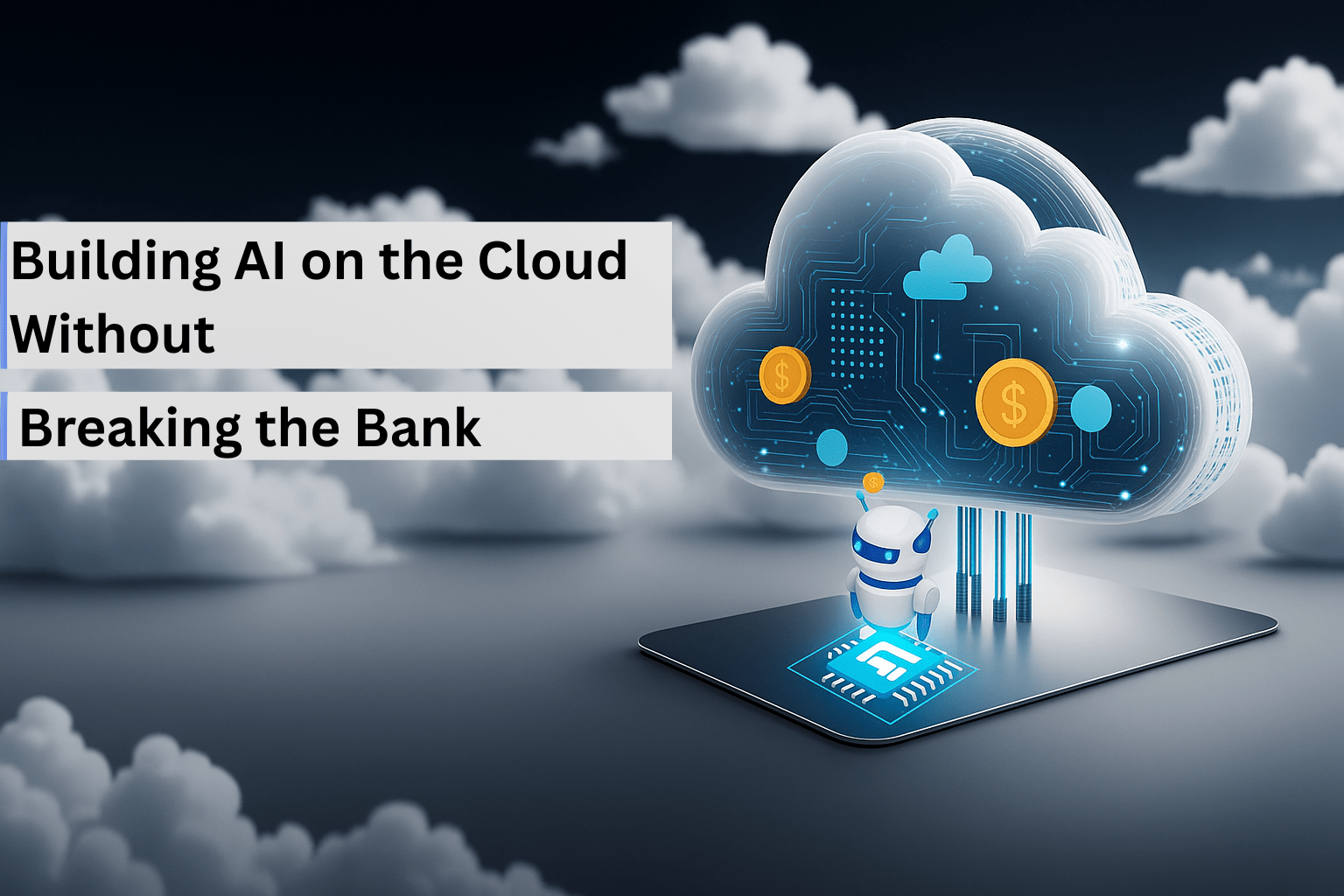Introduction
Artificial Intelligence has evolved from a buzzword to a business necessity. But with great power comes great expenses—especially when it comes to AI development. From massive datasets to GPU-heavy workloads, AI projects can burn through budgets fast. The good news? Cloud platforms are making it easier and more affordable than ever to build, train, and deploy AI solutions without breaking the bank.
Let’s dive into how you can build powerful AI systems using cost-effective cloud-based development environments.
Understanding AI Development Environments
What is an AI Development Environment?
Think of it as your AI workshop. It’s the combination of tools, infrastructure, and computing resources used to build, train, and deploy AI models.
Core Components: IDEs, Libraries, Frameworks
Most environments include:
- IDEs (like JupyterLab or VS Code)
- Libraries (like NumPy, Pandas)
- Frameworks (like TensorFlow, PyTorch, Scikit-learn)
Training vs Inference Environments
Training environments need heavy compute (GPUs/TPUs), while inference (running models in production) can be more lightweight. Understanding the distinction helps in budgeting smarter.
Why Cloud is the Preferred Choice for AI Development
Scalability and Flexibility
Need more compute power? Spin up a GPU instance in seconds. Done training? Scale down. Cloud platforms adapt as you do.
Pay-as-you-go Pricing Models
You’re only billed for what you use. No need to invest in costly hardware upfront.
Global Access and Collaboration
Teams across continents can access the same environment, making remote AI collaboration seamless.
Comparing Cloud Platforms for AI Development
AWS SageMaker
Amazon’s fully managed service lets you train, tune, and deploy models easily. Offers great integration with other AWS services but can be complex to set up.
Google Cloud AI Platform
GCP offers AutoML, Vertex AI, and support for TensorFlow. Their pricing is transparent, and they provide excellent free-tier resources.
Microsoft Azure ML Studio
Known for ease of use and integration with Microsoft tools. Great for beginners and enterprise-level experimentation.
Other Emerging Platforms
- Paperspace Gradient: Offers free GPU options for prototyping.
- Lambda Labs: Known for low-cost GPU compute with high performance.
Features to Look for in Cost-Effective AI Cloud Platforms
GPU/TPU Availability and Pricing
Not all clouds offer the same GPUs at the same rates. Always compare prices and availability in your region.
Open-source Tool Support
Platforms that support open-source tools reduce the need for paid services or licenses.
Storage and Networking Costs
Cheap compute doesn’t matter if storage costs kill your budget. Watch out for hidden storage and data transfer fees.
Billing Transparency and Budgeting Tools
Dashboards, alerts, and cost calculators help you keep track of what you’re spending.
How to Minimize Costs While Building AI in the Cloud
Choose the Right Instance Type
Don’t overprovision. Use only what your task demands—e.g., a T4 GPU for lightweight models.
Use Spot/Preemptible Instances
These can be 70-90% cheaper than regular instances. Great for non-critical, fault-tolerant jobs.
Set Auto-scaling and Resource Limits
Automatically scale compute up/down depending on the workload. Avoid paying for idle resources.
Schedule Idle Resources to Shut Down
Forget to turn off your GPU instance? Say hello to a surprise bill. Use auto-scheduling or reminders.
Take Advantage of Free-Tier Offerings
Most cloud providers offer limited free compute and storage each month. Use it for experimentation.
Open-Source Tools That Enhance Cost Efficiency
Jupyter Notebooks
Interactive development environments that run in-browser. Many cloud providers offer these pre-configured for free.
Docker and Kubernetes
Use containerization to standardize environments and minimize duplication. Kubernetes can scale pods efficiently based on usage.
Hugging Face Transformers
Leverage pre-trained models to avoid training from scratch. Hugging Face also offers inference endpoints.
TensorFlow Lite and ONNX
For optimized model deployment, especially on low-cost edge devices.
Real-World Use Cases of Cost-Effective AI Development
Startups Building MVPs
Instead of investing in infrastructure, startups use the cloud to iterate quickly and cheaply.
Academic Research Projects
Cloud credits from providers help researchers work on powerful systems without personal investment.
Enterprise AI Experimentation
Large enterprises use low-cost cloud platforms for pilot testing before full production rollout.
Case Study: Scaling AI on a Budget
A Startup’s Journey
A fintech startup began model training on local machines but soon hit compute limits. They shifted to Google Cloud’s preemptible GPU instances, cutting costs by 60%.
Challenges Faced
- Inconsistent spot instance availability
- Learning curve with cloud orchestration
Key Takeaways
- Monitor usage with budget alerts
- Use managed notebooks to speed up onboarding
Cloud-Native Services That Can Save You Money
AutoML Tools
Let the cloud do the heavy lifting of model selection and tuning, saving time and developer hours.
Managed Pipelines
Tools like Kubeflow or Vertex AI Pipelines let you automate model workflows and reduce redundancy.
Serverless Architectures
Run inference using functions instead of keeping machines on 24/7. Pay only per request.
How to Plan Your Cloud AI Budget
Understand Your Compute Needs
Estimate model complexity and dataset size to choose the right hardware.
Forecast Storage and Egress
Factor in the cost of storing models, logs, and transferring data out of the cloud.
Predict Training Time
Use dry runs or historical benchmarks to estimate training duration and optimize cost.
Hidden Costs to Watch Out For
Data Ingress/Egress Fees
While uploading is often free, downloading data can incur steep charges.
Long-Term Storage
Cold storage is cheaper, but it may not be suitable for all workflows.
License Fees for Proprietary Tools
Some tools and libraries charge per usage. Always read the fine print.
Tips for Choosing the Right Cloud Provider
Align with Your Tech Stack
Use providers that natively support your preferred frameworks and languages.
Community and Support
Look for active communities, documentation, and support options.
Long-Term Pricing Stability
Check if the provider locks pricing or offers committed-use discounts.
Future of AI Development in the Cloud
Edge AI and Hybrid Cloud
More processing is moving closer to the data. Expect a rise in hybrid cloud architectures.
AI Chips and Serverless AI
Custom chips (like Google’s TPU) and serverless deployments are transforming AI scalability.
Rise of Decentralized Training
Projects like Federated Learning and Blockchain-based compute are disrupting traditional cloud workflows.
Conclusion
Building AI in the cloud doesn’t have to be a money pit. With smart choices, strategic tools, and an eye on your budget, you can develop powerful AI applications without breaking the bank. Whether you’re a scrappy startup, a solo researcher, or an enterprise innovator, cloud platforms provide the flexibility, scalability, and affordability to bring your AI ideas to life.
FAQs
1. What is the cheapest cloud platform for AI development?
Platforms like Google Colab, Paperspace, and Lambda Labs offer affordable or even free tiers for basic workloads.
2. How can I reduce my cloud AI costs?
Use spot/preemptible instances, automate shutdowns, leverage open-source tools, and track your billing regularly.
3. Is cloud better than on-premise for AI?
For most users, yes. Cloud provides scalability, low upfront costs, and access to the latest hardware.
4. Can I train large models like GPT on a budget?
You can fine-tune pre-trained models instead of training from scratch. This dramatically reduces compute costs.
5. Are free cloud tiers enough for real AI work?
They’re great for learning and prototyping, but you’ll likely need paid services for production-grade models.







